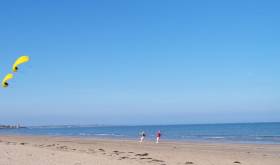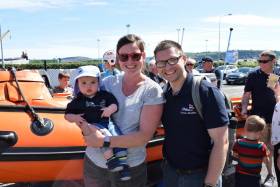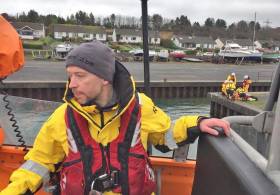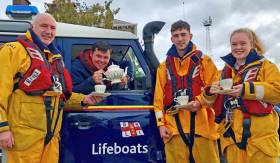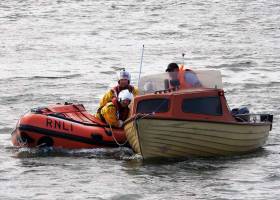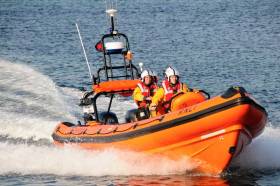Displaying items by tag: Larne
A member of the US Coast Guard and three of his relatives have been praised by the father of a young girl rescued after she was swept out to sea from a Dublin beach.
As The Irish Times reports, Walter Butler and his relations Eoghan Butler, Declan Butler and Alex Thomson leapt into action when they heard screams for help and saw the girl on a “pink floaty” off Portmarnock beach on Monday afternoon (22 July).
Butler remained on the beach ready to provide casualty care while the others swam out to the girl, who was swept some distance from shore and at one point was struggling to stay afloat after coming off her inflatable.
“We have all been swimming competitively since we were six or seven years old so to say we are good swimmers is an understatement,” said Butler — who noted that it still took half an hour for his relatives to reach the girl and swim her back to the beach, where paramedics and her relieved father were waiting.
The dangers of using inflatables at the seaside were highlighted again just hours later, when Larne RNLI launched yesterday afternoon (Tuesday 23 July) to a report of three people being carried out to sea on inflatable toys in Browns Bay.
At the scene, the volunteer crew found a small fishing vessel had already taken one casualty on board, and they look over to bring the remaining two onto the lifeboat.
RNLI volunteer helm Barry Kirkpatrick said: “We advise you not to use inflatables at the beach as offshore winds can easily sweep you off the shore in a very quick space of time.
“If you do get into difficulty or see anyone else in difficulty, please remember to call 999 or 112 and ask for the coastguard.”
Belfast Coastguard has warned that a number of children have been blown out to sea on inflatable toys in recent days.
“Please remember the safest place for children to play with these death traps is in the back garden,” a spokesperson said.
Portrush RNLI’s volunteer crew launched yesterday evening (Monday 22 July) to reports of a jetskier in difficulty at Benone Beach around 8.17pm.
The crew, who had just finished an exercise and had been stood down, launched the all-weather lifeboat in record time after the HM Coastguard request.
It was reported that three persons had already entered the water to assist the jetskier but had to return to shore to receive medical attention from the coastguard.
The lifeboat crew reached the jetskier at 8.35pm in smooth seas but with a strong offshore breeze which had hindered the three people attempting to assist.
After the jetski was secured alongside the lifeboat, the crew took the casualty on board, where he assessed and deemed to be medically fit.
It was then decided that the jetskier and his craft should be taken back to the beach, using the all-weather lifeboat’s smaller Y boat, to the waiting coastguard.
Des Austin, coxswain of Portrush RNLI, said after the callout: “The jetskier had no wetsuit on and even in a balmy summer evening the water is still very cold, so it was important that we reached him as soon as we could.
“There was also a strong off shore wind which made it difficult for the other swimmers to assist, so the members of the public did exacty the right thing by calling for help.
“It’s also key for us to make sure that the jetski is recovered also as it could pose a hazard if not taken out of commission.”
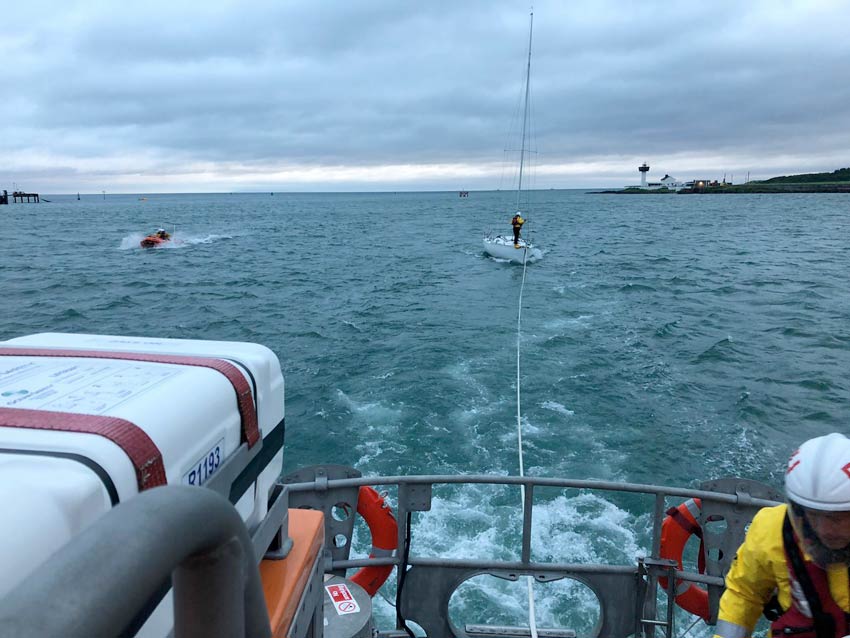 Larne RNLI tows the 37ft yacht back to East Antrim Boat Club | Photo: RNLI/Samantha Agnew
Larne RNLI tows the 37ft yacht back to East Antrim Boat Club | Photo: RNLI/Samantha Agnew
Much earlier in the day, Larne RNLI volunteers’ pagers sounded at 5am after reports that a 37ft yacht had broken its moorings at East Antrim Boat Club and run aground in Larne Lough, causing a potential hazard to the shipping lanes.
Both lifeboats were launched 10 minutes later in moderate seas on an overcast morning, and once on scene it was decided to place a crew member from the inshore lifeboat on the casualty vessel to secure a tow line.
Once brought into deeper water and assessed as being safe and undamaged, the yacht was then towed by the larger all-weather lifeboat to a spare mooring back at East Antrim Boat Club.
“It was an early start for our volunteers this morning and we had a good turnout of crew for the callout.” said Larne’s lifeboat operations manager Allan Dorman.
“This scenario is something that we practice during training and I was glad to see that everyone worked together for a successful outcome.”
This past Saturday 22 June, Larne RNLI opened its doors to the public to celebrate 25 years of saving lives at sea in the local area.
Since the station opened in in 1994, Larne lifeboat volunteers have launched 514 times, saving 34 lives and rescuing 454 people, with an average of 21 shouts per year.
Larne RNLI celebrated this 25th Anniversary milestone with its supporters who have made their work possible on a fun-filled family day with visitors from far and wide taking the opportunity to see the inshore lifeboat up close and meet the local crew.
Visitors — which included Mayor of Mid and East Antrim Maureen Morrow — also had the chance to see a video of recent rescue launches and training to get a real feel for what the Larne volunteers do on a weekly basis.
RNLI lifeguards also attended with their rescue boards and sea safety messages, teaching young and old how to enjoy a trip to the beach safely this summer.
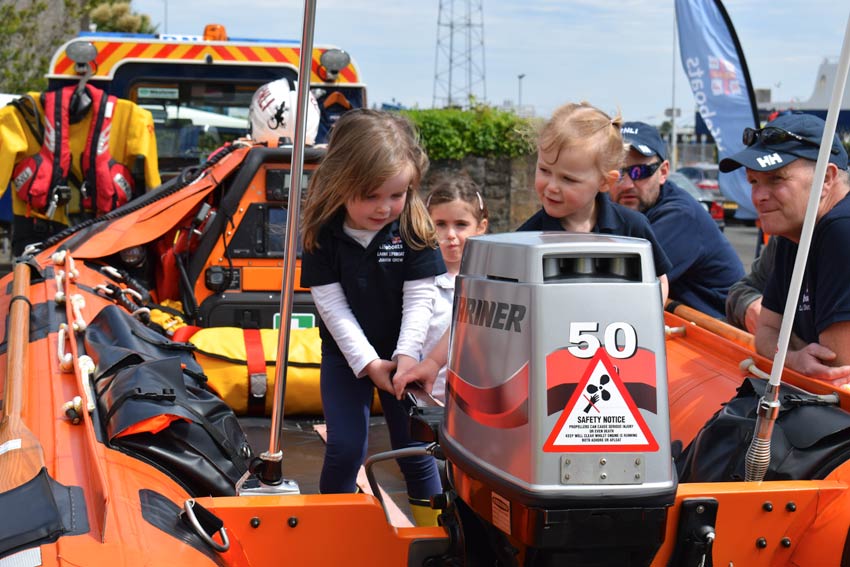 Junior crew Isla Kirkpatrick and Megan Ford-Hutchinson helming the inshore lifeboat | RNLI/Larne
Junior crew Isla Kirkpatrick and Megan Ford-Hutchinson helming the inshore lifeboat | RNLI/Larne
Two Northern Ireland Ambulance Service paramedics brought along an ambulance allowing people to step inside, see the equipment they carry and try out being a patient.
Pets as Therapy UK also kindly attended with their dogs allowing peoples of all ages to hear about their work and meet the animals.
The open day was also a fundraiser for the lifeboat, and a total of £772.48 was kindly donated by visitors on the day. This money will go towards the work of Larne RNLI allowing the charity to continue to save lives at sea in the local area.
Phil Ford-Hutchinson, Larne RNLI’s deputy launching authority, said: “We would like to thank everyone who attended, very generously donated and helped make it a very special day.
“We would also like to thank all the local businesses who supported us and helped make our 25th anniversary open day such a success.”
Food was provided by Asda, Woodland Woodies, Creed, McDowells, Bake, Ann’s Pantry and Upper Crust. Got U Covered Gazebos provided shade from the sun, DJ Stephen Snoddy provided music, and Larne Port Ltd provided free parking for visitors. The event was also supported by Mid and East Antrim Borough Council and East Antrim Boat Club.
Larne RNLI has a close-knit group of volunteers, both crew members and fundraisers, with a strong family ethos and team approach to ensure everyone plays their part to help saves lives at sea on the east Co Antrim coast.
Recently, one of these volunteers — Barry Kirkpatrick, a local teacher — completed his assessments to qualify as an RNLI all-weather lifeboat coxswain.
“Being an RNLI volunteer is a big commitment but working alongside like-minded people, to help those in distress at sea, is very rewarding,” Barry said.
“It’s very much a team approach at Larne RNLI with a fantastic camaraderie within the crew.”
The commitment to the lifeboat isn't only measured in the time spent involved in rescues, but also in the essential weekly training scenarios.
The volunteers in Larne RNLI, who come from all walks of life, train six times per month to ensure they are fully trained on all aspects of rescues including keeping up to date with new and evolving equipment.
With only one in 10 lifeboat crew members having professional maritime experience, the charity’s comprehensive competency-based crew training is vital to saving lives at sea.
And when the pagers do go off, volunteers are ready to drop everything as they’re called away from their families, their beds and their work, 24 hours a day, 365 days a year.
“Our crews train extensively across a broad spectrum to gain the skills and knowledge necessary to be a member of the lifeboat crew,” says Larne RNLI coxswain Frank Healy. “This means giving time and dedication to meet the requirements.
“This was realised recently when Barry, after long, intensive and wide-ranging training, was passed out successfully as an all-weather lifeboat coxswain. A great achievement for Barry who is a very valuable asset to Larne station.”
In 2019 Larne RNLI is celebrating 25 years of local volunteers providing its rescue service to the Larne area. Over the last 25 years, Larne lifeboats have launched 514 times, saving 34 lives and rescuing 454 people, with an average of 21 shouts a year.
To celebrate the work of volunteers and the support the local community have provided, Larne RNLI are holding an open day at the lifeboat station on Olderfleet Road on Saturday 22 June from 12pm-4pm.
Everyone is welcome to come along, meet the volunteers and enjoy a fun-filled day with a BBQ, bouncy castles, our mascot Stormy Stan and lots more.
It was a busy weekend for RNLI lifeboats in Arklow, Larne and Kilmore Quay which each had callouts over the Easter period.
Arklow RNLI launched on Sunday afternoon (21 April) to assist a jetski in difficulty following a launch request from the Irish Coast Guard at 3.15pm.
The volunteer lifeboat crew left their families on Easter Sunday to answer the callout, bringing the all-weather lifeboat Ger Tigchlearr just north of Arklow Harbour where the casualty vessel had been reported adrift and without power.
The jetski, with two people aboard, was quickly located off the back of Arklow's North Pier, dangerously close to the rocky shoreline.
The two people aboard were immediately recovered onto the lifeboat and a line was secured to the jetski to tow it back to shore.
In Larne, RNLI volunteers were called out twice on Sunday evening to people in difficulty.
In the first callout, both the all-weather and inshore lifeboats were called to aid two kayakers who had overturned near Browns Bay just off Islandmagee.
Larne RNLI launched into a calm sea at 5,45pm with the inshore lifeboat, Terry, tasked to bring the kayakers safely to shore, while the all-weather lifeboat Dr John McSparran was tasked to recover the kayaks left behind.
After a successful recovery of both casualties and their equipment, Larne RNLI helm Pamela Leitch noted: “The two kayakers were wearing buoyancy aids; they also remembered to stay with their kayaks which made it easier for us to identify them and bring them ashore.”
The second callout involved the all-weather lifeboat towing a 26ft sailing boat which had run aground at the East Maidens lighthouse.
One of the two people onboard had asked to dock close to the Maidens so they could have a look around. However, while they were the docked the tide ebbed and the boat was left on rocks.
The remaining crew member was able to use their VHF radio to call for assistance from Belfast Coastguard, who requested the launch of the all-weather lifeboat.
When Larne’s volunteers reached the boat, they found that it had moved off the rocks and that no damage had occurred to the hull.
However, it was suggested that the casualty boat follow the all-weather lifeboat into Larne to assess any further damage.
As both boats were making their way into the Port of Larne, a tow line was established as the casualty vessel was experiencing some engine troubles. The vessel was then towed to a mooring at East Antrim Boat Club.
Meanwhile, in Kilmore Quay, the local RNLI lifeboat was alerted by Dublin Coast Guard at 5.25pm that an 11m boat with two people on board had lost engine power three-and-a-half miles south of Bag-N-Bun Head to the west of Kilmore Quay.
Conditions were near calm at the time with restricted visibility due to coastal fog. Visibility was down to one tenth of a mile at times.
The volunteer crew made best speed towards the casualty vessel, arriving alongside twenty minutes later. A tow line was passed over and the vessel was towed back to Kilmore Quay, which took just under an hour to complete.
The four Easter Sunday callouts came after Saturday launches for Courtmasherry RNLI, to a Spanish-bound yacht in distress, and Carrybridge RNLI, to two boats in difficulty on Upper Lough Erne.
“Given the fantastic weather we’ve had this weekend, we’ve seen higher numbers of people coming back to the beaches and putting their boats and other craft back in the water, earlier than usual,” said Mark Corcoran, community safety officer at Arklow RNLI.
“We’d like to remind people to always respect the water, wear a lifejacket and carry a means of calling for help when going out on the water.”
Youghal’s RNLI volunteers were presented last week with a cheque for €3,439.60 from the organisers of the Ardmore Christmas Day swim.
The event was first organised in 1997 and has successfully run every Christmas Day since. The swim is always well supported by the local community and 2018’s was no exception.
The swimmers met on the beach at Ardmore at 12.15pm on Christmas Day in dry but chilly conditions and made the dash into the water for a quick dip before heading back to the beach for a hot drink.
Youghal RNLI’s inshore lifeboat, Gordon and Phil, and her volunteer crew were there on the day to oversee the safety of the swimmers.
Lifeboat operations manager Derry Walsh said: “We would like to send our thanks to everyone who came out on Christmas Day and took part in the swim, and a special thank you to those who have organised the swim over the last 22 years.
“The RNLI depend on the generosity of the public to save lives at sea, and this donation will help to ensure our lifeboat and crew are always ready when they are called upon.”
Elsewhere, a callout for Larne RNLI to a suspected vessel in trouble on Friday evening (29 March) turned out to be false alarm as smoke seen rising from a vessel at the Maidens was part of a training exercise.
Paul Johnston, Larne RNLI deputy launching authority, said: “We would like to commend the member of the public for contacting the coastguard and raising the alarm. We would always much rather launch to find all is safe and well than not launch at all.”
Local Artist Presents Larne RNLI With Lifeboat Painting
Last Thursday evening (15 November) Larne RNLI lifeboat crew and station management welcomed Geoff Johnston and his wife Caroline to the station.
Geoff’s hobby is painting and the artist presented the lifeboat crew with an incredible painting of their all-weather lifeboat, Dr John McSparran.
Geoff said his interest in the lifeboats started when he visited Donaghadee’s station when he was younger.
Having done paintings for Newcastle, Donaghadee, Portrush RNLI and now Larne, Geoff says he isn’t stopping.
“I’d like to try and do a painting for every station in Northern Ireland,” he said. “Next time I’d like to attempt one of the inshore lifeboats.”
Larne RNLI coxswain Frank Healey said: “The painting is absolutely amazing. The work and detail that Geoff has put into it, is remarkable.
“It will look fantastic hanging in our station for all the crew and any visitors to see.”
Larne Lifeboat Crew To Open Their Doors For Macmillan Charity Coffee Morning
#RNLI - Larne’s volunteer RNLI crew are throwing open the doors of the lifeboat station as they host a coffee morning to raise funds for Macmillan, the cancer support charity, from 10.30am to 2pm on Saturday 29 September.
The crew are already planning a ‘bake off’ to entice the public along and to dig deep for Macmillan.
There will also be tours of the station, demonstrations of its vital lifesaving kit and talks to give an insight into lifeboat launches in and around Larne.
Eleganze Hair & Beauty, Marty’s Catering, Curran Court Hotel and Allan Dorman & Son are among the local businesses that have already shown their support with raffle prizes for the day.
“This will be a fundraiser with a difference for us here,” said lifeboat mechanic Derek Rea. “As a charity we are thankful to the people of Larne for supporting the lifeboat but we also want to help others and raise funds for this worthy cause.
“There is hardly a person whose life has not been touched by cancer, either through battling it themselves or seeing someone they care about suffering with it. Support for cancer sufferers and research into treatment is ongoing and the Macmillan coffee morning is a great way to raise awareness and funds for this work.”
The lifeboat station is situated at 11 Olderfleet Road in Larne and people wishing to learn more about the Macmillan coffee morning fundraisers can visit macmillan.org.uk.
Wicklow Lifeboat Aids Angling Boat With Mechanical Failure
#RNLI - A small angling boat with one person on board was towed to safety by Wicklow RNLI after it got into difficulty near Wicklow Head on Wednesday evening (8 August).
The angler had earlier departed from Wicklow Port for a day’s fishing along the coast, but was unable to get the engine into gear to return to the harbour.
The inshore lifeboat launched shortly after 6pm with helm Vinnie Mulvihill and crew David O’Leary and Graham Fitzgerald, and located the drifting craft near Wicklow Head eight minutes later. Weather conditions at the scene were calm with a northerly wind force three.
The angling boat was taken in tow back to Wicklow Harbour and the angler was landed safely ashore.
Elsewhere, Clifden RNLI continued what’s been a busy August when the volunteer lifeboat rescued a boy separated from his kayak at Omey Island earlier on Wednesday afternoon.
The youngster and his friend were holidaying on the island in Claddaghduff with their families, who raised the alarm when one of the boys was seen in the water with his friend trying to help him.
Following the coastguard request after 2.30pm, the Atlantic 85 lifeboat launched from Clifden while the D Class lifeboat travelled by road and was launched at Claddaghduff. Winds were Force 6 and gusting to 7 at the time.
When the Atlantic 85 reached the scene, they found people waving from the eastern shore of the island and saw that the two boys involved had made it ashore to another beach in the area, where some other visitors were assisting them.
Clifden RNLI helm Thomas Davis manoeuvred the lifeboat close to the shore and crew member James Mullen then swam to attend to the boys before reuniting them with their families. They were cold and shaken after the ordeal but otherwise unharmed.
Speaking after the callout, Mullen said: “We were really glad to have been able to assist these lads and their families today and always encourage anyone concerned to raise the alarm as quickly as possible.
“Conditions at sea in this area can change rapidly even for experienced water users and we are always on hand to help where we can.”
The RNLI advise all kayakers to always carry a means of calling for help and to keep it in reach at all times.
More recently, Carrybridge RNLI’s rescue water craft and inshore lifeboat Douglas Euan & Kay Richards, were requested to launch by Belfast Coastguard to assist a man who was disorientated whilst navigating Tamlaght Bay in Upper Lough Erne in the early hours of this morning, Friday 10 August.
And Larne RNLI’s all-weather lifeboat and inshore lifeboat crews recently carried out a training exercise to simulate a casualty care and extraction scenario.
Bundoran Lifeboat In Two Sunday Calls For Assistance
#RNLI - Bundoran RNLI responded to two calls for assistance yesterday (Sunday 22 July) by an angling boat with a fouled propeller and a yachtsman suddenly taken ill.
The volunteer lifeboat crew launched after 10am following a call to go the aid of an angling boat, with two men onboard, which had got into difficulty when the boat’s propeller got tangled in lobster pots just off Bundoran.
The lifeboat, helmed by Killian O’Kelly and with three crew members onboard, launched in good weather conditions and made its way the short distance to the scene.
Having assessed that those onboard were safe and well, the lifeboat crew worked with the two men to free the boat and tow it safely back to shore.
Later in the day, the pagers sounded once more at 4.30pm, following a request from the Irish Coast Guard to assist a man who had taken ill on a yacht off Mullaghmore.
The lifeboat, helmed on this occasion by Brian Gillespie and with three crew members onboard, launched immediately and made its way to the scene. The Sligo-based coastguard helicopter Rescue 118 was also tasked.
On arrival, the lifeboat crew assessed the man before taking him onboard the lifeboat and administering casualty care. Once ashore, the man was treated for the effects of sea sickness but was otherwise safe and well.
Speaking following the callouts, Bundoran RNLI volunteer lifeboat operations manager Tony McGowan said: “We were delighted to be of assistance to both groups yesterday and glad that the outcomes resulted safely.
“We would remind everyone visiting the sea and enjoying Bundoran this summer to always respect the water. Always wear a lifejacket, always carry a means of communication and always let someone ashore know where you are going and when you are due back. Should you get into difficulty, call 999 or 112 and ask for the coastguard.”
Elsewhere, Larne RNLI was called to assist the crew of a small motorboat with engine difficulties at the entrance to Larne Harbour yesterday morning.
Larne’s volunteer lifeboat crew were preparing for a training session when the call came through at 10.10am. Both the all-weather lifeboat and inshore lifeboat launched to the casualty vessel.
Larne RNLI’s all-weather relief lifeboat the Duke of Windsor was was quickly on scene just north of the entrance to Larne Harbour. The crew quickly established a temporary tow to move the vessel out of the shipping lane to allow a P&O ferry to exit the harbour.
A line was then passed from the lifeboat and secured to the casualty vessel to tow the vessel back to Larne Boat Club.
In the shallow waters of Larne Lough the tow was passed to the inshore lifeboat Terry in order to guide the vessel onto the slipway for recovery.
Speaking after the callout, Larne RNLI coxswain Frank Healy said: “We are glad that the crew on the motor vessel knew to contact the coastguard when they got into difficulty, this is always the right thing to do. If we can be of assistance to anyone, our volunteers are here to help.”
This was the second launch for Larne RNLI in the last five days.
On Wednesday 18 July, the station's all-weather lifeboat launched with their colleagues at Bangor and Donaghadee as a precautionary measure for an aircraft inbound to Belfast City Airport that was experiencing technical difficulties.
The aircraft landed safely and all three lifeboats were stood down and returned to station.


























